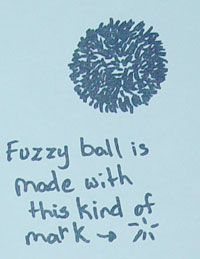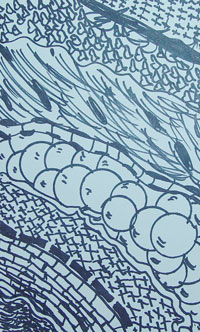Fourth Grade Art Lesson 4
Elements of Art, Part 3 Lines and Texture
Objective:
The student will know how to create line variation and understand why it matters in drawings and know that texture is the quality of a surface. The student will use ink to draw line variations and texture.
Materials:
another small card, any type of ink pen
Procedure:
Today we are going to focus on the art elements line and texture. First we know that a line is the path of a moving point. Lines can be represented in many ways. Line variation is when a line changes from thick to thin and/or from light to dark. Using line variation in your work makes it more interesting to look at. Creating line variation is not difficult, but simply requires that you notice the quality of your lines and work with them to give them greater interest. You may need to press down harder on your tool to get a darker line, or lighten up on your tool to get a lighter line. Making a line thicker requires you tracing over it several time. Making your lines interesting results in a more interesting drawing. Texture is the quality of a surface. It tells us how something feels. Using texture in your drawings makes them more believable and gives greater visual interest. Much like line, texture is not difficult to do but requires your patience. You can create visual textures by simply piling up a consistent mark until you have filled in an area. Today I want us to practice making line variations and textures. Divide your card into several sections. Make the lines you use to divide you space vary in quality. Make some lines thick and thin and light and dark. Be creative! Fill up the blank space between your lines with texture. Try making one area look fuzzy, or fill in an area with bricks or stone. Look around your room to find textures and discover ways to reproduce them. Typically you will find it a matter of making a single mark over and over again until it takes on a textural quality. Again, be creative!
Conclusion:
Review the meaning of line variation and texture. Look at the work produced by the class and discuss the various textures you find. Look closely to see how they made them look the way they do. Also notice the line variations and how they give grater interest than one single pen point line.
Artwork and Examples used in this lesson

Teacher Example

Teacher Example

Teacher Example

Student Artwork













